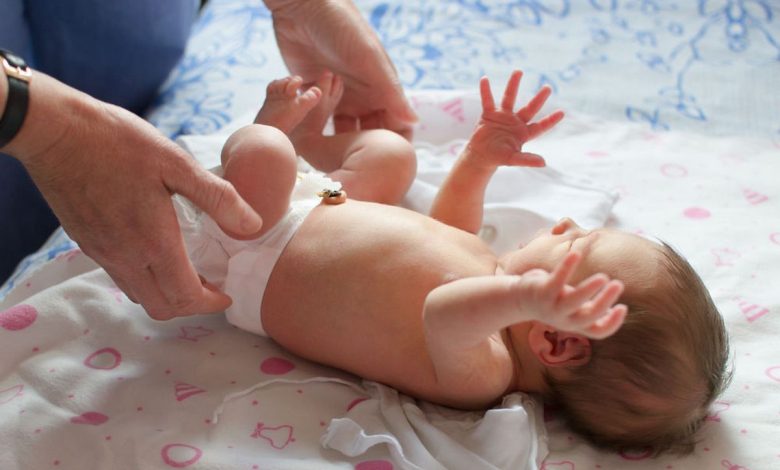Moro reflex in babies (startle reflex, embrace): What's it, causes, symptoms, diagnostics, treatment, prevention

Moro reflex; Startle response; Startle reflex; Embrace reflex
What is the Moro reflex?
Moreau reflex, also known as startle reflex, is a primitive reflex, seen in neonates and infants. This is a normal defensive reflex., which usually disappears between three and six months of age. When a baby is suddenly frightened, he reflexively throws out his hands, and then pulls them back to his body, as if to calm down or console. The Moro reflex is an infant's response to loud noises., abrupt change in movement or loss of support from the caregiver.
Your baby's doctor will check for this reflex right after birth and during your baby's checkups..
To see the Moro reflex, the baby is placed face up on a soft, padded surface.
The head is lifted gently with sufficient support. (note: do not tear the baby's body from the pillow)
Then the head is abruptly released, allow for a moment as if to fall back, but quickly support again (must not, for the child to hit the back of the head on the surface).
The normal reaction of a child is a frightened look.. The child's arms should move to the sides, palms up., and the thumbs are bent. Baby can cry for a minute.
At the end of the reflex, the baby pulls his arms to the body, bends the elbows, and then relax.
Causes of the Moro reflex
The Moro reflex is an involuntary and normal response to loud noises or sudden movements., that disturb the infant's balance or sense of, what is holding him. This reflex usually occurs due to anxiety, fear or if the environment suddenly becomes too loud or bright.
Absence of the Moro reflex in infants is abnormal.
- Absence on both sides of the body suggests damage to the brain or spinal cord.
- Absence on only one side suggests a fracture of the humerus or damage to a group of nerves, running from the bottom of the neck and the top of the shoulder to the arm (these nerves are called the brachial plexus).
Moro reflex in older infants, children or adults is abnormal.
Moro reflex symptoms
The Moro reflex is characterized by shuffling of the hands and feet with wide spreading of the fingers and toes., which is usually followed by the closing of fingers and toes and crying. The baby arches its back and stretches its legs, while the handles are twitching and thrown outward, away from the body, which is often accompanied by a loud cry. The reflex will last a few seconds, and the baby will look like this, like he's trying to "spread his wings".
When to see a doctor
It is important to monitor the Moro reflex and any other primitive reflex in your infant., as it may indicate a potential developmental delay. Should see a doctor, if the Moro reflex does not disappear or if the reflex is absent, despite all the usual stimulation efforts, as this may indicate a problem, related to your child's development.
Questions, that your doctor may ask
When visiting a doctor, you may be asked questions such as:, as:
- When did you first notice the Moro reflex in your child??
- Does your child have a Moro reflex every time he flinches??
- Does the reflex seem more exaggerated, than other babies you know?
- What actions cause this reflex?
- Is the Moro reflex response normal for your child's age??
Diagnosis of the Moreau reflex
The doctor diagnoses the Moro reflex, observing the baby's reflex reaction to a loud noise or sudden movement. If the reflex does not occur or if the doctor notices any abnormalities in the reflex, the infant may need additional diagnostics.
If the reflex is absent or abnormal, additional tests may be needed to examine the child's muscles and nerves. Diagnostic tests in cases of reduced or absent reflex may include:
- Shoulder X-ray
- Tests for disorders, associated with brachial plexus injury
Treatment of the Moreau reflex
The Moro reflex usually resolves without any special treatment., as the child becomes more aware of his surroundings and begins to gain control of his body. The goal of treatment is to ensure that, so that the reflex remains normal and disappears on its own without any problems.
Moro reflex home treatment
Since the Moro reflex is normal, primitive reflex, there are several things, what parents can do, to help their babies develop this reflex in a normal way. The most effective way to stimulate the Moro reflex is to hold and hold the baby in a safe position., and then make sudden movements or loud noises. Also important, that your child is in a safe environment and, so that no sudden movements or sounds frighten him.
Moreau reflex prevention
Since the Moro reflex is a normal reflex, it is impossible to prevent its occurrence. Nonetheless, there are certain precautions, what parents can do, to ensure the normal development of the reflex. It is important to make sure, that the environment is safe and secure for the baby, and also make sure, that he is properly hugged and held, which can help reduce any anxiety or fear, that can trigger a reflex.
Used sources and literature
Herring yes. The orthopaedic examination: a comprehensive overview. In: Herring yes, ed. Tachdjian’s Pediatric Orthopaedics. 6th ed. Philadelphia, PA: Elsevier; 2022:chap 3.
Schor NF. Neurologic evaluation. In: Kliegman RM, St. Geme JW, Bloom NJ, Shah SS, Tasker RC, Wilson KM, eds. Nelson Textbook of Pediatrics. 21st ed. Philadelphia, PA: Elsevier; 2020:chap 608.
Volpe JJ. Neurological examination: normal and abnormal features. In: Volpe JJ, Inder te, Darras Bt, et al, eds. Volpe’s Neurology of the Newborn. 6th ed. Philadelphia, PA: Elsevier; 2018:chap 9.
